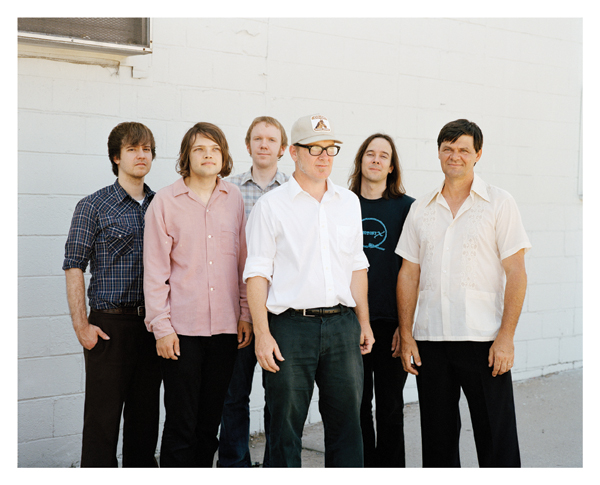
Lambchop. Photo by Michael Schmelling
Videos by American Songwriter
Strangely, a lot of American artists are doing better in Europe than in the States. And it’s been going on longer than you’d think.
“To British people there is always an element of sighing wistfully at the romantic ideal of the pioneer spirit and the checked plaid shirts, beards, and Levi’s,” says Simon Raymonde, who runs the London-based label Bella Union, home to American artists like Midlake and John Grant, which is marketed and distributed by Yep Roc Music Group in the U.S.
Midlake, a group of former jazz musicians from Denton, Texas, became enamored with obscure British folk music before recording their 2010 album, The Courage Of Others. Midlake may sound like folk music on the surface – or “Americana” – but really they don’t fit with what’s traditionally considered folk music in the States. Similarly, John Grant, whose album Queen Of Denmark was recorded in Texas with Midlake, doesn’t fit a typical genre. Grant’s record was released in the U.S. last April to little fanfare, but topped Mojo’s Top 50 Albums Of 2010 this past December. Phil Waldorf, who co-founded the U.S. label, Dead Oceans, and built the U.S. campaign for Phosphorescent’s Here’s To Taking It Easy around the album’s European release and the band’s overseas touring opportunities, says he was amazed to witness the apotheosis of John Grant on a recent visit to London. It seemed to run in such stark contrast to Grant’s U.S. exposure.
On the flip side, British folk act Mumford & Sons have sold out American clubs and auditoriums, mostly catching on with younger fans. Kristof Ellinghaus, who runs the Berlin-based label City Slang, which has recently put out the album Invariable Heartache from KORT, the partnership of Nashville’s Kurt Wagner, of Lambchop, and Cortney Tidwell, says in Europe you’ll often find older fans of American folk-influenced music.
“[Americana] seems to be a musical field mined mostly by older music fans. The younger folks in Germany are dancing to such different beats, it’s quite interesting. Where you can see loads and loads of young people getting into KORT or Iron & Wine and the like in places like Norway and elsewhere, in Germany you will see an audience made up mostly of what we call ‘silver surfers,’” he says.
For Caribou’s Swim, another City Slang album, which was released in the U.S. on Merge, Ellinghaus says the label took a completely different approach. “We launched the last Caribou album in Berlin’s darkest, most menacingly Germanic and notorious club called Berghain. A techno temple. Full of dark rooms and Italian tourists. We launched the KORT album in a church. A beautiful sounding church.”
While Ellinghaus says he’s not much of a fan of Americana, he first discovered Kurt Wagner’s Lambchop in the midst of ‘90s-era grunge. “It sounded rustic and ambitious without really being able to cover up the fact that the band couldn’t play,” he says about Lambchop’s I Hope You’re Sitting Down. “[It] was 14 people trying to be as quiet as possible. We thought it was genius. And Kurt’s voice was the standout instrument. Plus, we noticed that the album art very prominently displayed a big huge pair of dog’s balls. How could we resist?” Ellinghaus says by 2004, UK clubbers had embraced Lambchop’s Nixon as their favorite “chill-out” record. Though he doubts that Americans who like dance and electronic music would show the same openness.
Raymonde says American audiences focus too much on genres and the perception of being cool. “We think [Midlake] is super cool,” he says. “Because we appreciate that they’re amazing musicians with hearts and souls. Writing such moving songs about our world and how we relate to it is cool.”
The fragmentation and decentralization of culture also plays a part. “I think finding the best new music on the Internet is like looking for a new planet in a cloudy sky,” says Raymonde. He and Ellinghaus both say they’ve mainly discovered American bands from tapes or through other bands. Ellinghaus recently signed two new American bands, Tu Fawning and Wye Oak, and he says the reason was simply because they’d made records that blew him away.
Mike Quinn, founder of the Brooklyn-based label No Quarter, which released Doug Paisley’s Americana gem Constant Companion, warns that the UK can be a difficult nut to crack for aspiring artists. “I’m still not sure what the formula is for selling records and gaining traction there,” he says, though he mentions that getting good press usually leads to more shows. Waldorf says once Phosphorescent’s record, which did well in the U.S., started to take off in Europe, the label kept pushing, coupling a year-end bonus disc with the album for a special Rough Trade promotion.
Raymonde says the best advice for gaining traction in Europe is to research and understand the European market and find the people – journalists, publishers, labels, agents, radio shows – who play your favorite music. “E-mail them, ask them for help. You’d be surprised. People are usually only too happy to help smart, self-motivated people.” But Raymonde, a founding member of influential ‘80s group The Cocteau Twins, hints at another underlying truth. “If you strip away all this crap, if I love a band to the point of obsession, if no one else is trying to sign them, if they sound like something I haven’t heard before, then we can start a conversation. Otherwise, I am not so bothered.”
Editor’s Note: A previous version of this article stated that neither Midlake or John Grant have a U.S.-based label. Bella Union serves as the label for Midlake and John Grant in both the U.S. and Europe. Some Bella Union artists are signed only for European distribution and maintain a separate U.S.-based label for distribution in the U.S. (Beach House, Vetiver, Fleet Foxes). Bella Union records are marketed, promoted, and distributed by Yep Roc Music Group in the U.S.
3 Comments
Leave a Reply